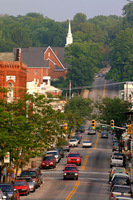 | Back to e-WV
| Back to e-WV
 The West Virginia Encyclopedia
The West Virginia Encyclopedia
 | Back to e-WV
| Back to e-WV
 The West Virginia Encyclopedia
The West Virginia Encyclopedia

Lewisburg, the county seat of Greenbrier County, was established as a town by the Virginia General Assembly in 1782. Previously, the area had been known as Fort Savannah, Camp Union, and Big Levels. Lewisburg is at the crossroads of the Seneca and Midland trails, now U.S. 219 and U.S. 60, and modern Interstate 64.
Pioneer John Lewis and his sons, Thomas and Andrew, camped in what is now Lewisburg while surveying the area in 1751. In 1774, Gen. Andrew Lewis assembled more than 1,000 men there for the 160-mile march to Point Pleasant, where the frontier militia narrowly defeated Indians led by Cornstalk.
Lewisburg’s birth can be credited, in large measure, to the presence of the Lewis Springs, but its growth from settlement to town also benefited from the mustering of the militia there. Other circumstances that contributed to Lewisburg’s growth were the construction of forts west of the Greenbrier, and its role as the county seat of Greenbrier County. After 1831, an annual session of the Virginia Supreme Court met at Lewisburg, and a state law library was established there.
Lewisburg was the site of a battle during the Civil War on May 23, 1862. Union troops under the command of George Crook defeated the Southern forces, led by Henry Heth. At the Confederate Cemetery on McElhenney Road, a cross shaped mass grave holds the remains of 95 Confederate casualties of the battle. Union Maj. Rutherford B. Hayes, later president, served at Lewisburg.
A devastating blow occurred August 3, 1897, when fire destroyed much of downtown. Lewisburg rebuilt and evolved in the next century into the hub of one of the state’s major farming areas and a center for education and the arts. The West Virginia School of Osteopathic Medicine was established in 1974 at the former Greenbrier Military School. The Greenbrier Valley branch of the New River Community and Technical College, and Carnegie Hall, a regional cultural center, are housed on the former campus of Greenbrier College.
Today, a major employer is British United Turkeys of America, which combines technology and agriculture to produce turkey breeding stock. The Robert C. Byrd Clinic, which opened in 1997 at the School of Osteopathic Medicine, provides family health care to a six-county area. Tourism is a growing industry.
Homes, churches, art galleries, antique shops, restaurants, professional offices, and other businesses occupy many of the 18th- and 19th-century structures designated in 1978 as a historic district in the National Register of Historic Places. The Old Stone Presbyterian Church is said to be the oldest church building in continuous use west of the Alleghenies. Lewisburg celebrates New Year’s Day with Shanghai, a costume parade. The annual West Virginia State Fair takes place at neighboring Fairlea. The Greenbrier Valley Theatre was started in the 1960s as an outlet for actors and local playwrights, such as Pinckney Benedict. In 2011, Lewisburg was named Frommer Budget Travel Magazine’s “Coolest Small Town in America.” The 2020 population of Lewisburg was 3,930, an 8.4 percent increase since the start of the 21st century.
Written by Belinda Anderson
Benjamin, J. W. Rutherford B. Hayes Stayed in Lewisburg in 1863. West Virginia Daily News, 3/3/1976.
Lindsley, Helen. Ah. . . The Shanghai. Come, Walk with Me: A Nostalgic View of Lewisburg. Parsons: McClain, 1982.
An Introduction to Lewisburg. Come, Walk with Me: A Nostalgic View of Lewisburg. Parsons: McClain, 1982.
Montgomery, John F. Glimpses of Lewisburg through the Years. Come, Walk with Me: A Nostalgic View of Lewisburg. Parsons: McClain, 1982.
Swope, Kenneth D. The Great Lewisburg Fire: August 3, 1897. The Journal of the Greenbrier Historical Society, vol. 3, (1981).
Turley, C. E. The Lewisburg Historic District. The Journal of the Greenbrier Historical Society, vol. 3, (1981).